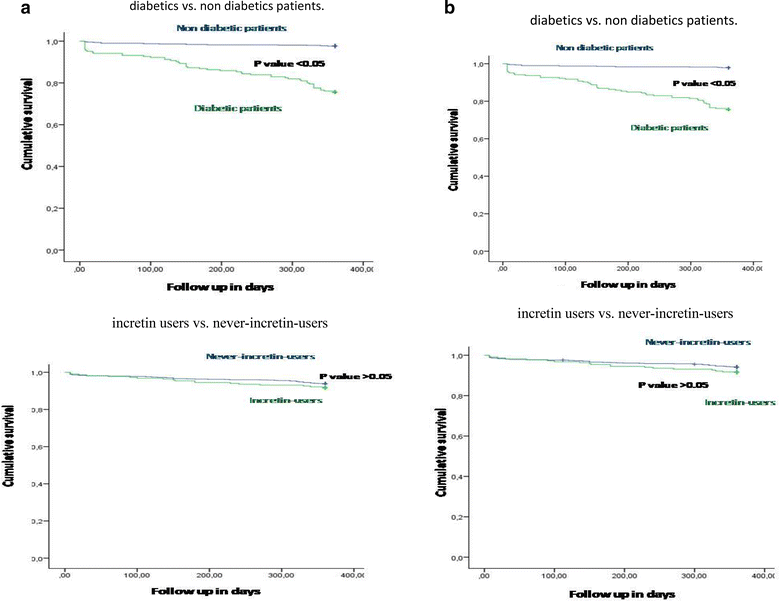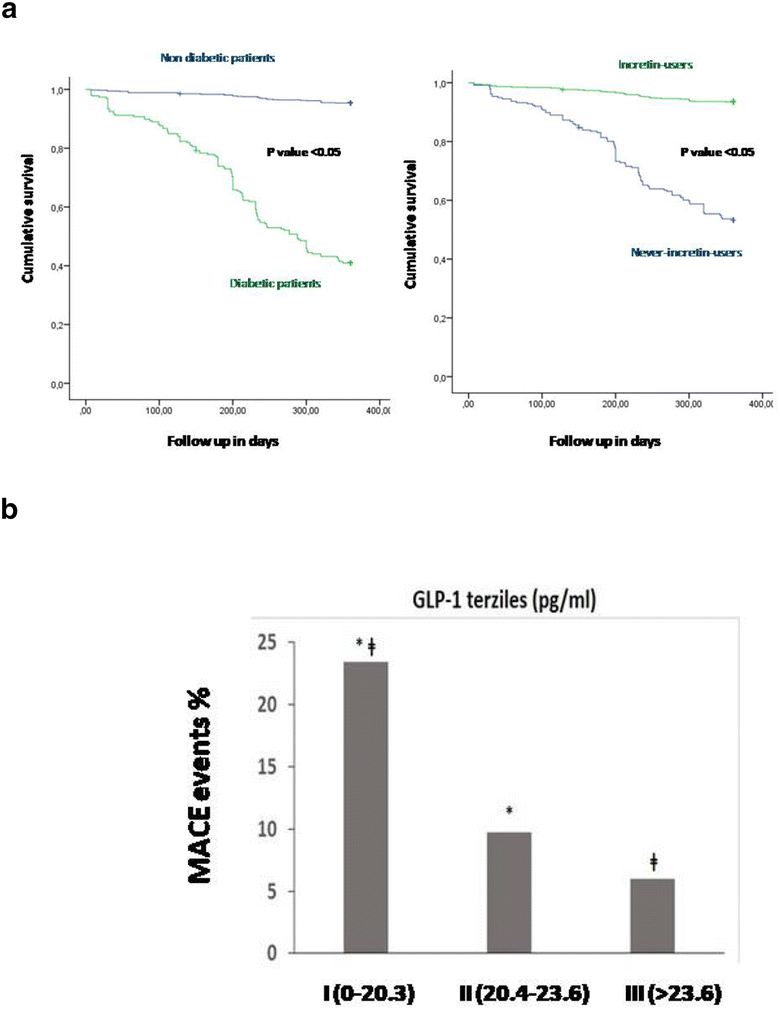Effects of incretin treatment on cardiovascular outcomes in diabetic STEMI-patients with culprit obstructive and multivessel non obstructive-coronary-stenosis
- PMID: 29308090
- PMCID: PMC5751832
- DOI: 10.1186/s13098-017-0304-3
Effects of incretin treatment on cardiovascular outcomes in diabetic STEMI-patients with culprit obstructive and multivessel non obstructive-coronary-stenosis
Abstract
Background: No proper data on prognosis and management of type-2 diabetic ST elevation myocardial infarction (STEMI) patients with culprit obstructive lesion and multivessel non obstructive coronary stenosis (Mv-NOCS) exist. We evaluated the 12-months prognosis of Mv-NOCS-diabetics with first STEMI vs.to non-diabetics, and then Mv-NOCS-diabetics previously treated with incretin based therapy vs. a matched cohort of STEMI-Mv-NOCS never treated with such therapy.
Methods: 1088 Patients with first STEMI and Mv-NOCS were scheduled for the study. Patients included in the study were categorized in type 2 diabetics (n 292) and non-diabetics (n 796). Finally, we categorized diabetics in current-incretin-users (n 76), and never-incretin-users (n 180). The primary end point was all cause deaths, cardiac deaths, and major adverse cardiac events (MACE) at 12 months of follow up.
Results: The study results evidenced higher percentage of all cause deaths (2.2% vs. 1.1%, p value 0.05), cardiac deaths (1.6% vs. 0.5%, p value 0.045), and MACE (12.9% vs. n 5.9%), p value 0.001) in diabetic vs. no diabetic patients at 12 months follow up. Among diabetic patients, the current vs never-incretin-users, did not present a significant difference about all cause of deaths, and cardiac deaths through 12-months. The MACE rate at 1 year was 7.4% in diabetic incretin-users STEMI Mv-NOCS patients vs. 12.9% in diabetic never-incretin-users STEMI-Mv-NOCS patients (p value 0.04). In a risk-adjusted hazard analysis, MACE through 12 months were lower in diabetic STEMI-Mv NOCS incretin-users vs never-incretin-users patients (HR 0.513, CI [0.292-0.899], p 0.021). Consequently, lower levels of glucagon-like peptide 1(GLP-1) were predictive of MACE at follow up (HR 1.528, CI [1.059-2.204], p 0.024).
Conclusion: In type 2 diabetic patients with STEMI-Mv-NOCS, we observed higher incidence of 1-year mortality and adverse cardiovascular outcomes, as compared to non-diabetic STEMI-Mv-NOCS patients. In diabetic patients, never-incretin-users have worse prognosis as compared to current-incretin-users.Trail registration Clinical trial number: NCT03312179, name of registry: clinicaltrialgov, URL: clinicalltrialgov.com, date of registration: September 2017, date of enrollment first participant: September 2009.
Keywords: Non-obstructive coronary stenosis; STEMI; Type 2 diabetes.
Figures


References
-
- Kim DH, Burton JR, Fu Y, Lindholm L, Van de Werf F, Armstrong PW, CAPTORS II Investigators What is the frequency and functional and clinical significance of complex lesions in non-infarct-related arteries after fibrinolysis for acute ST-elevation myocardial infarction? Am Heart J. 2006;151:668–673. doi: 10.1016/j.ahj.2005.05.006. - DOI - PubMed
-
- Ibanez B, James S, Agewall S, et al. ESC guidelines for the management of acute myocardial infarction in patients presenting with ST-segment elevation: The task force for the management of acute myocardial infarction in patients presenting with ST-segment elevation of the European Society of Cardiology (ESC). Eur Heart J. 2017;00:1–8 - PubMed
LinkOut - more resources
Full Text Sources
Other Literature Sources

